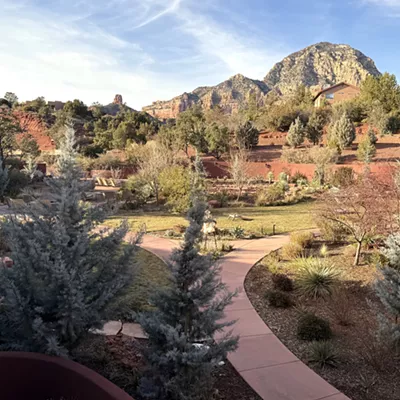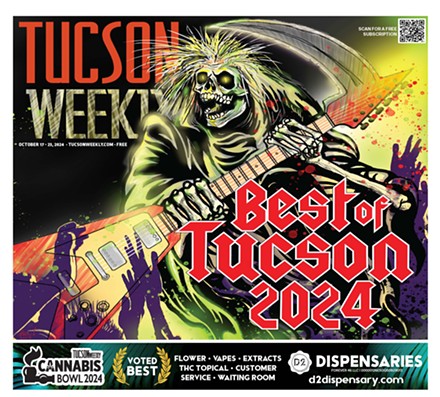The City Charter, the guide and rulebook for everything from division of power to obscure investment restrictions within Tucson's 124-year-old government, is once again on trial. It stands accused of being outdated, contradictory and stifling. But the more scrutiny thrown onto the charter, the more that labor, civil rights groups, neighborhood activists, emerging political parties and just plain citizens are turning an unfriendly spotlight on the accuser--the Southern Arizona Leadership Council. It is that group of bankers, car dealers, developers and business executives, most of whom live outside the city and cannot vote in city elections, that is trumpeting charter reform this time around.
Closely aligned with Republican Mayor Bob Walkup, who has backed previous and failed charter revision efforts, the Leadership Council wants to:
· scrap the city's partisan elections and instead have the top two finishers of the primary face each other in the general election;
· add two wards, and council offices, to the current six;
· boost the mayor's legislative power by counting the mayor in the council quorum and by granting the mayor a vote in the firing of the city manager or the few other city officials for whom the council has a say in termination.
The proposals have stirred a chorus of criticism in the ward forums the council ordered as well as at a council hearing held last month. Libertarian and Green party members, labor, the National Association for the Advancement of Colored People, the League of United Latin American Citizens, neighborhood activists and just plain citizens have appeared to denounce the Leadership Council's recommendations and tactics.
Near the close of one such forum last week, hosted by eastside Democratic Councilwoman Carol West, Clarence Boykins, president of the Tucson chapter of the NAACP, noted the recent Memorial Day celebrations. They were, he said, for all those who had fought for democracy, and yet the proposed charter revision got its start this time from an exclusive group.
"'We the people' means something," said Boykins, a longtime city employee who is an executive at the Tucson Convention Center. "There's something to that. It's not 'we the group' or 'we the organization.'"
Boykins also has picked apart the pieces of the charter revision in earlier forums. But he has also flatly opposed the Leadership Council's approach, to devise the amendments and then seek a four-vote council majority to place them on the ballot. It is a view shared by the other critics, who contend that for something so fundamental to city government, the Leadership Council should have gone the other route--the hard route of the initiative process, of getting the 12,000 signatures of Tucson voters to place the issues on the ballot.
"You've got a group that is well meaning but it thinks it knows best what's best for Tucson with no discussion," Boykins says. "There's a belief that we can't think for ourselves. It's very simple. If we're not part of the process, it's not a good process."
Boykins recalled local political experience, a painful one, in the state's rejection of a Martin Luther King Jr. holiday, an embarrassment that was caused in no small part by having "a small group tell a big group what's best for it." That was corrected in a subsequent drive, an inclusive one that resulted in passage.
Paul Rubin, Southern Arizona director for the United Food and Commercial Workers Local 99, asks at the forums "Why are we here?" to set up his talk about how a powerful organization could draw up charter amendments for what essentially is ratification by Walkup and three council members.
On the issue of elevating mayoral power, Rubin has another question. "Would we be talking about increasing the mayor's power had Molly McKasson won in 1999?"
No one at the hearings can say yes.
McKasson, a Democrat and a heroine for both Greens and neighborhood activists, was soundly defeated by Walkup.
STEVE EMERINE IS ONE OF the moderate Democrats who helped defeat McKasson and, though he is not a member of the Southern Arizona Leadership Council, he has been left to defend the proposed charter amendments.
A former editor at the Arizona Daily Star and the Tucson Citizen, Emerine also served as Pima County assessor.
The provision to give the mayor a vote on city executives as well as inclusion in the quorum count are needed, Emerine says, to clear up the inconsistencies left by those who wrote the charter in 1929. The group may have even been a little sloppy, Emerine has said, including the mayor in some areas and excluding the mayor in others.
Incorporated in 1877, the city had relied on a charter approved six years later until 12 men and two women were elected as freeholders to draft revisions in 1929.
They chopped up the powers and duties of the mayor. The charter names the mayor as the chief executive officer of the city and gives the mayor emergency powers, but Tucson's version of hizzoner is well short of an all-powerful Rudy Giuliani, Richard Daley or Willie Brown. In one section of Tucson's charter the mayor is part of the "governing body" but in others the mayor, though empowered with a vote on most matters, simply is described as the chairman of the council for meetings.
And the mayor has a vote in appointing a city manager, but no vote to remove the manager. Similarly, the mayor has a vote in the selection of the city attorney and city clerk, but no vote if a majority of the council wants to dump one of those officers. The police and fire chiefs are appointed by the manager with approval or ratification of the mayor and council, and can be terminated by the manager or a majority of the council, with no mayoral vote. The same process is in place for the finance director, human resources director and the parks and recreation director.
The Arizona Daily Star, then under the leadership of the powerful and pushy William R. Mathews, supported the changes, calling the new charter the "framework for good government." Seventy-two years later, the Star's new editor and publisher, Jane Amari, in Tucson only since October 1999, has taken a seat on the Southern Arizona Leadership Council. Moderating a panel on the charter changes at a forum sponsored last month by City Councilwoman Shirley Scott, a Democrat who represents southeast-side Ward 4, Amari insisted she had nothing to do with the language of the proposals.
Tucson in 1929 had 32,000 people living within 7.1 square miles. The city was split into just two wards, the First Ward taking in area north of Congress Street and Tenth Street, with the Second Ward running south of Congress and Tenth. The charter was briefly news for front pages otherwise dominated by turbulence in Mexico and the crossing of the Arizona border by Mexican federal troops. A credit crisis foretold of greater economic troubles, and it was a period in which the newspaper identified African-Americans as Negroes not only in stories but in headlines and when race was totally irrelevant.
The city budgeted $2,040 for the charter writing committee and spent another $4,300 for publishing and $200 to stage the election. (Elections now cost more than $1 million.) On the strength of the mostly white First Ward on the north side, the charter passed 1,113 to 703, or 61 percent to 39 percent. The measure was rejected on the largely Hispanic southside Second Ward by nearly 2-1. "Heavy Adverse Vote Due to Fear Spanish Americans Will Lose Rights," read the subhead in the Star.
"We feel the charter drafted by our board is the best possible under the circumstances and are confident that the events will prove its worth," Dr. Meade Clyne, chairman of the charter committee, told the Star.
The mayor, W.A. Julian, didn't share the joy, saying he had nothing to say about the charter passage. Nor did he want to discuss the appointment of a city manager--a new requirement. "No, I have no one in mind."
Charter changes, the Star said, would lead to efficiency and professional administration, and bring an end to the "power of political patronage." Besides creating the new level of a city manager, the charter brought civil service into the police and fire departments. The changes became effective when Gov. John C. Phillips signed the new charter and delivered it to Mayor Julian nearly two months after the vote, when the governor was in town to speak at the Tucson High School graduation.
THIRTY-ONE CHANGES, mostly technical, have been approved on a steady basis since the first amendments in 1941. But fundamental change, like switching from a council-manager form of government, was studied by a blue-ribbon panel in 1982. That study came while the powerful and talented Joel Valdez was in the middle of his 17-year career as manager that made Tucson seem that it was led by an appointed mayor. The panel's recommendations went nowhere. Not even to the ballot.
Nine years later, the Tucson Business Coalition stimulated charter reform with a proposal for a strong-mayor form of government--the mayor as the elected executive working with a legislative council. The business coalition, created more than a year earlier in response to complaints of mistreatment of business by city and county government, wanted to put the mayor in charge of the city manager. Placed on the ballot through the collection of nearly 14,000 signatures of Tucson voters--the threshold was 11,900--the business coalition's proposal gave the mayor veto power, with council ability to override with a three-fourths vote.
The other key reform would have eliminated citywide council elections and forced council candidates to win their wards. That worried Janet Marcus, a Democrat then seeking a second term in Ward 2. For good reason--she failed to carry her ward even as an incumbent and instead was carried by the city's overwhelming Democratic voter registration advantage. Marcus was not alone as a ward loser. Multi-term Republican Roy Laos was an anomaly. He drew fewer votes in the heavily Hispanic southside Ward 5 in 1985 than Democrat Dick Jaskiewicz and yet won the seat in the citywide election.
Marcus, Bruce Wheeler--a Democrat then representing westside Ward 1--and Steve Leal, the Democrat who knocked out Laos in 1989, served as the council's charter committee in 1991. As they developed their recommendations to rival those of the Tucson Business Coalition, they toyed with the 1982 plan. Mayor Tom Volgy, a Democrat, also devised his own recommendations for a strong-mayor form of government. Volgy, a longtime council member and a professor of political science at the University of Arizona, was not seeking a second mayoral term. Two of his predecessors, Lew Murphy, a four-term Republican, and James Corbett, a one-term Democrat, came out in favor of a strong-mayor form of government. Both said that year that the time had come for Tucson to have an elected chief executive.
Things had changed. Valdez retired and moved on to a vice president position at the UA, and Tucson had grown to 409,755 people and 158.3 square miles.
The council waited until August that year before approving charter revisions for the November ballot. The key proposal retained the method of council elections--nomination by ward and election citywide--but it contained some increases in mayoral power. A second council charter reform package boosted council power over appointed department heads.
The top combatants for mayor that year, Republican George Borozan and Democrat George Miller, the winner, both spoke against the strong-mayor proposals. "It's not the power of the chair, but the power of the person in the chair," Borozan said.
Voters nonetheless faced three separate propositions--one from the Tucson Business Coalition and two from the city--and rejected each by overwhelming margins.
Byron Howard was the chairman of the Tucson Business Coalition. He later worked with Miller to seek another round of charter changes that also had the support of Miller's successor, Bob Walkup. Miller, like Walkup, was seeking a lure for Casas Adobes and Catalina Foothills annexation and, with less drama and less effusiveness than Walkup, dangled council seats as bait. But that drive in 1998 was, beyond Howard's knowledge or control, riddled by fraudulent petition signatures and phony work by a petition passer and the subject of police and grand jury investigations. Howard, whose Democratic run for the Board of Supervisors last year fell short to Republican Ann Day, now is the top aide to Councilwoman Scott.
Another drive last year faltered, and now the city faces the possible revision brought by a powerful lobby that consists mostly of non-residents.
STEVE LYNN, A PUBLIC-relations executive for Tucson Electric Power, helped Miller beat Borozan 10 years ago as a partner in an advertising agency. He also is the chairman of the powerful state committee that will redraw congressional and legislative districts. Confronted by criticism of the charter proposals and their origin, Lynn says that the battle has become one "that if you don't like the message, shoot the messenger."
He told the audience at one of the forums sponsored by Scott that his group was proud to "take full credit for it being our idea." Among the Southern Arizona Leadership Council are Joe Coyle, president of Raytheon; David Mehl, developer of La Paloma, Dove Mountain and other properties; Hank Amos, the inheritor of Tucson Realty & Trust and a member of the Arizona Board of Regents; Michael Hard, president of Bank One in Tucson; Chris Monson, a top executive for Don Diamond's real estate ventures and head of Diamond's Rocking K development; and John Munger, a Tucson lawyer and former member of the Board of Regents.
Lynn got battered, not only by the activists but also by John Butesh, a retired restaurant owner from Detroit, who wasn't buying pleas of pure civic altruism.
"What's in it for you?" Butesh barked at Lynn.
Lynn's group also could take credit for giving rise to opposing forces including political organizations like the Citizens for Fair Voting and two contrarian lawyers, Brad Holland and Peter Hormel, who have appeared before the committee.
Holland turned one of the forums upside down with persistent questions, including those directed at the Star's Amari, about the Southern Arizona Leadership Council. He had an unlikely ally in Ken Rineer, a gun rights advocate, who said that the leadership council should not be so touchy. If a gun group drafted charter changes and sought City Council action to put them on the ballot, people would be asking a lot of questions.
And Lynn tried to downplay his outside-the-city residence; he said he always is in favor of annexation. Holland seized on that and encouraged Lynn to move to Holland's neighborhood, where there was no shortage of available housing.
Holland, a musician who has a pro-bono law practice, likes not one part of the package, not even the one he says "seems benign" that would add to the mayor's role. The mayor has enough power, Holland says, by controlling the agenda and running the meeting.
The provision to include the mayor in the quorum count is a direct response to the walkout that Democratic Councilmembers Jerry Anderson, Steve Leal and Jose Ibarra staged last year to protest Walkup's plans for big-box stores in the El Con Mall redevelopment. The move forced a quick cancellation of that meeting.
Hormel, who represents indigent clients in the Pima County Legal Defenders Office, strikes at the Southern Arizona Leadership Council for sidestepping the petition process on something he says is "so fundamental to democracy."
"The petition process serves a real and legitimate purpose," Hormel says, in educating citizens with "literature and street-level participation."
Katie Bolger, the leader of the Green Party in Pima County and an unsuccessful legislative candidate last fall, told the City Council last month that the Southern Arizona Leadership Council skipped a necessary step. The petition process, she said, "is a litmus test to see if an issue has enough support to get on the ballot. They need to go out and educate 12,000 people and have them sign."
Emerine, the former newspaper man who now is a public-relations consultant, doesn't see reason to fault the leadership council for seeking the charter changes through the City Council. All the group is asking is for the issues to be on the ballot. Once there, Emerine says, it will be determined by Tucson voters and not members of the leadership council who live outside the city.
Democrats have controlled the City Council since 1973, the last year Mayor Murphy had a GOP majority in Mike Borozan, Ray Castillo and Bob Royal. Non-partisan races should not give rise to new fears by Democrats, Emerine says. Heavily Republican Phoenix, he notes, has had recent and successful Democratic mayors, Paul Johnson and Terry Goddard.
Even Brent Davis, an articulate and straight-shooting Ward 2 Democrat who served two terms on the City Council ending in 1987, favors non-partisan elections, added wards and the boost in mayoral power.
A party loyalist, Davis nonetheless used Richard Fimbres, a member of the Pima Community College Board of Governors and a national vice president for LULAC, to demonstrate the lack of danger in non-partisan races.
Fimbres, who joined a panel with Davis last week at the eastside City Hall, said he wanted to have council races remain partisan. Party identification, he said in a sentiment shared with others, is an important piece of information for voters.
But Davis turned the tables when he asked Fimbres about the non-partisan status of Pima College board members.
Yet when the inevitable cliché, sometimes attributed to Murphy, is tossed out about how there is no Republican way to fix the streets and no Democratic way to pick up the garbage, labor leaders like Paul Rubin jump up.
"There is, as a matter of fact, a Democratic way to pick up garbage and to fix streets," Rubin says. "Whether it will be done with employees who are treated and paid fairly with benefits or whether the services will be contracted out to the lowest bidder with no regard to the workers."
And John Zajac, a leader of the Libertarian Party in Arizona, says that if people want non-partisan elections, they are free to run as independents.
CAROL WEST SERVED AS A COUNCIL aide to Janet Marcus and after a period away from city government she returned to claim the Ward 2 seat of her former boss in the 1999 election. West has earned a reputation for diligence and hard work, even from those who have opposing positions. She feels overworked and hard-pressed to keep up with more than 80,000 constituents. Tucson, now spread over 223 square miles, has 496,575 residents. Adding two wards would shave 20,000 people from West's and the other wards.
That argument is encountering trouble, though, because of Walkup's promise that reluctant Casas Adobes and foothills residents will have their own wards.
Fimbres is the chairman of Steve Leal's campaign for a fourth term, and his wife is one of Leal's ward aides. Fimbres says costs for the two new wards are prohibitive given the city's current budget shortfall.
"When you are raising taxes and cutting services, I don't see how you can justify the increased costs for two new council members, staffs, buildings and vehicles," Fimbres says.
Leal has been vociferous in his opposition to council expansion, complaining not only of increased office and personnel costs, but of diminution of neighborhood programs instituted through the city's Back to Basics program.
There has been one emerging consensus among this year's players in the charter debate: that council members must work hard and full time for low pay--$18,000 a year--and some other changes should be explored.
It has revealed, Emerine said at the conclusion of a congenial discussion last week, that compared to the Board of Supervisors, whose members are paid $54,600 a year, the City Council is a big bargain.








